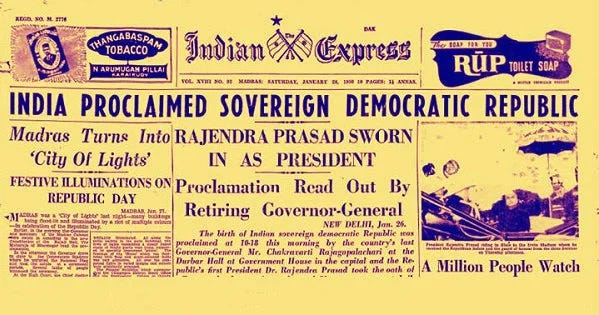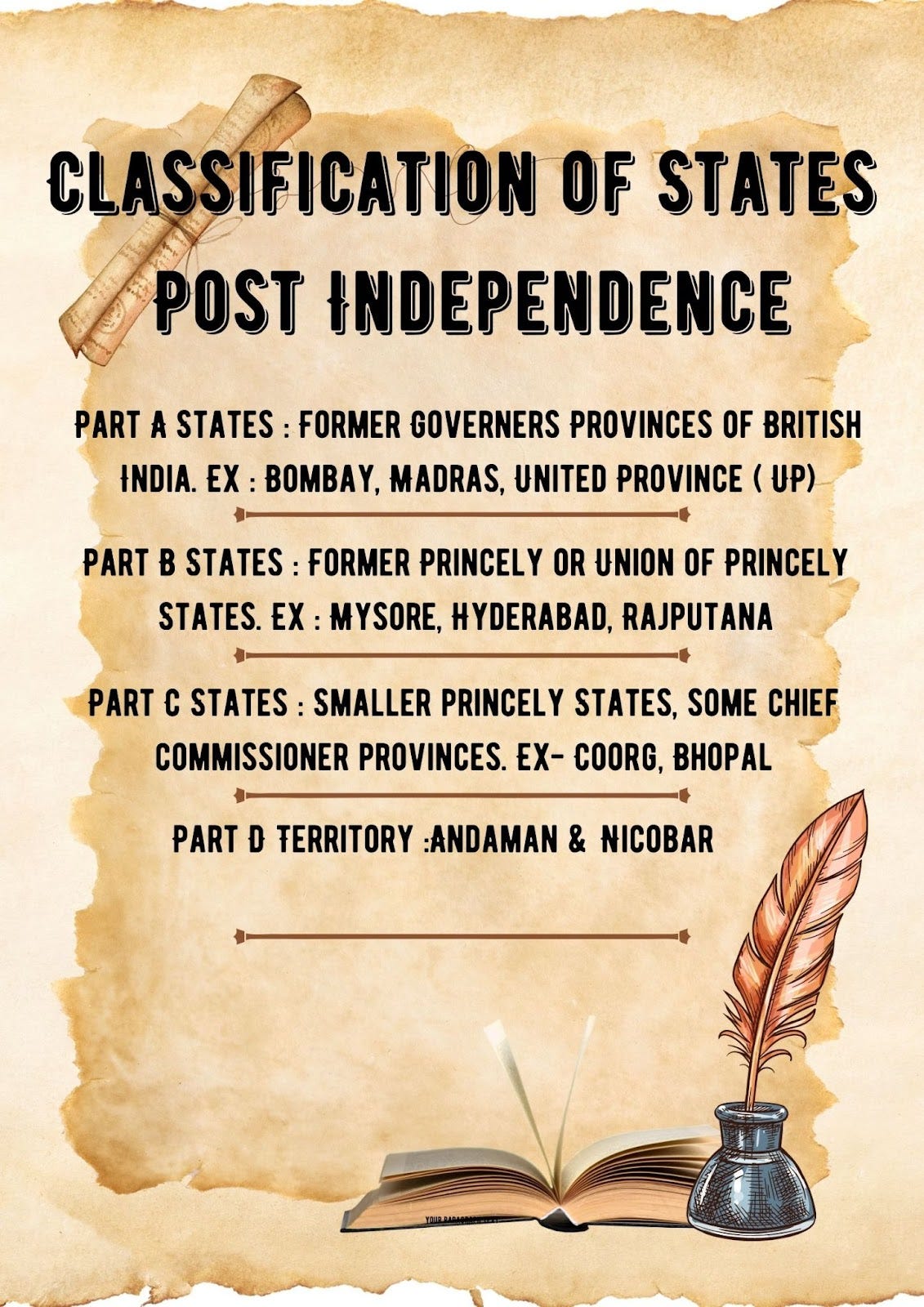The Origin of India's States : Outlining an important chapter of our history
#16- The book is a comprehensive chronicle of the incentives & imperatives at play post Independence that led to the formation of Indian states.
India got its independence in 1947. The efforts and sacrifice of millions over generations saw fruition. But with this great power, came great responsibility. The responsibility to keep India united. Build a country that not just survives, but thrives.
The post Independence turbulence was a torrid time. The partition left the country wounded. But that wasn’t the only challenge. In this article, we pick the book ‘The Origin of India’s states’ by VenkataRaghavan Subha Srinivasan, to look at the period of formation and reformation of states and union territories of India. The book is a comprehensive walk through this period and outlines the incentives & imperatives at play.
If you prefer listening to the essay instead of reading, you can play it below.
Scroll down if you would like to continue reading.
One common human assumption is that our reality is the only timeless one. We are blinded by the prism of our context and evaluate everything using that lens. The way we define a player as G.O.A.T or a movie of not having aged well, we operate under the selection bias of only our context.
This is exactly why history has a huge role to play. It gives us context. It gives us a tunnel to travel back and refine our world view. It opens us to the circumstances back then, that led to people making certain choices.
From independence in 1947, if asked to recount a few years that really shaped India, the prominent ones to come to mind would be - 1950 ( Implementation of constitution & India becoming a Republic), 1962 ( The Indo-China War), 1965 & 1971 ( Indo- Pak war), 1975 ( Implementation of emergency), 1983 ( India won cricket world cup), 1984 ( Indira Gandhi assassination, Bhopal Gas Tragedy), 1991 ( India opened up its economy), 1992 ( Babri masjid demolition), 1999 ( Kargil war), 2011 ( India won cricket wold cup- again), 2014 ( Rise of Narendra Modi in national politics).
Mind gravitates towards recollectiom of either celebratory milestones or moments of distress. That’s why the most lasting memories are of politics, sports or huge social change. But there are some critical periods which left an indelible mark on our present, but aren’t spoken of in detail. This is similar to how we recollect memories.
We remember the big milestone moments - the first travel, first movie, passing board exams, graduation, first job, marriage, birthday of a kid. But there are a lot of anecdotal dates that we may not remember, but those days may have contributed heavily in shaping who we are today.
One such year in India’s political and social history was 1956.
We just crossed November 1st. The usual, casual 24 hour amble on to the next date. For some, November 1st may not have any significance. Some may know it as Karnataka Rajotsava day. Aishwarya Rai fans would remember it as her birthday. But not many look at this day as a landmark date in Indian history. On 1st November 1956, the State reorganization act was implemented : India’s state boundaries was divided into 14 states and 6 centrally administered territories.
What was so special on the Thursday morning of 1st November 1956 that such a massive restructuring was done? This origin story of each Indian state, amidst political and social uncertainty goes back to India’s independence in 1947. The world leaders had written the country off- it was doomed to fail. It was too heterogenous to be able to function together.
This mega movement is what forms the subject of the book- The Origin story of India’s states by Venkataraghavan Subha Srinivasan.
Flashback to 1947
India’s tryst with destiny. The British empire finally made an exit. But the founding fathers of the independent nation had a daunting task ahead of them. The key apprehensions of the young nation were political, social & economic.
Political challenges -
The country saw steep political challenges : rehabilitation of migrants during partition; communal unrest because of the partition ; administrative future of princely states ; growing unrest in the south due to demand for linguistic bifurcation of states. Even foreign policy had to be meticulously approached. The world had just come out of the second world war and entered its new wave of challenge - division into factions because of the cold war.
Social challenges -
While the political incentive of independence had united the nation till 1947, our social issues were prominent. The society was marred with caste inequality, income disparity, low literacy rate ( 12%) and health issues( infant mortality). The founding Independent Indian Government had to give a direction that would be instrumental to shape the country’s future generations. This vision led to the Indian Constitution.
Economic Challenges -
Post war resources were massively crunched. The US and UK economies were in a state of high inflation. India was battered by the plundering of British rule over two centuries and needed to rebuild its economy. This needed policies that could leverage the strength of agrarian resources and build capabilities to become an industrially strong economy.
Each of these challenges are subject matters worth comprehensive research. The book ‘ The Origin of India’s states’ focuses on the political challenge at hand and the course of events that led to the formation of Indian states.
Indian administrative structure at the time of independence wasn’t as simple. The Indian subcontinent was a sum-total of ‘British administered India’ and ‘Princely states’, the latter being a nominal sovereign entity of the British empire.
There were 562 princely states, which administered over approx 40% of Indian geography. While partition into India & Pakistan was a big setback, there was a parallel challenge of integrating the princely states into the Union of India. It was a period of new aspirations, new motivations and a new sense of purpose, but also one of uncertainty. Independence was an objective that had united an entire generation. They made it their core purpose. But now, there was vacuum which made the heterogeneity, the differences more prominent.
Thus, began possibly one of the most challenging political, social and economic exercises. It was a core agenda of the Government. A journey that would broadly take a decade.
The Book : The Origin of India’s States
The book chronicles the journey of each state. It chronicles the course of events that led to the formation of each state. How states would look like in free India. was a debated point before independence itself. There was broad consensus in the Congress party, on language homogeneity being a key variable. It was also part of the Congress Manifesto in 1945-46.
But the effect of unrest due to partition made the Government sceptical about the timing of further birfucations. This was clearly put out by the JVP committee ( comprising Pandit Jawaharlal Nehru, Vallabhai Patel and Pattabhisitaramayya).
But protests and political unrest going out of hand in Andhra Pradesh made the Government concede and Andhra Pradesh was bifurcated from Madras state. In the anticipation of a domino effect, the Government set up a State Reorganization commission in 1953. Their recommendations were submitted in October 1955 and implemented via State Reorganization Act in November 1956. This was and continues to be the biggest such exercise in Indian post-Indepedence history.
The core tenets factored by the committee were :
Linguistic and cultural homogeneity
Administrative capability basis size
Social & economic welfare of all constituencies within the state
Seamless integration between the princely states
The book covers in detail the journey of each of the states- alphabetically. This approach may mean that some facts would feel repeated. But as a reader, it didn’t deter my reading experience. The style worked because the narrative is ripe with facts and incidents, and revision helped to register them better. So when we read the journey of Andhra Pradesh , the common elements of separation from Madras state would repeat in the chapter about Tamil Nadu as well. .
The writing is lucid and uses comprehensive research as its strongest narrative device. This doesn’t mean that it ends up being just dates and events. There is enough storytelling at play. We see the backstory of events, stakeholders involved, possible motivations and repercussions of the decisions. The book gives a wholesome view.
One doesn’t need to follow a linear reading style. You can pick any state and read about it. Chances are you will pick the state-
you were born in or belong to
state where you have spent your childhood ( if its not the same as 1)
State that you really like to travel to
Irrespective of the order picked, every chapter is well researched, detailed out and full of pertinent particulars.
Sample the journey of Karnataka. The core intent of getting the Kannada speaking population together. Kannada speaking population was spread across 20 provinces, prominently in 5 provinces
Mysore state ( dominant Kannada)
Madras state ( dominant Tamil & Telugu)
Hyderabad state ( Dominant Telugu)
Coorg ( Dominant Kannada & Kodavu)
Bombay State ( Dominant Marathi)
The unification was spread across multiple stages. The first step was unification of Mysore state in the Republic of India Then Bellary was integrated from Madras state. Post this Raichur, Gulbarga & Bidar were merged from Hyderabad state. Belgaum followed from Bombay. Coorg was the last to join. All this took almost a decade and came to fruition during the State reorganization of 1956. From 1956 to 1973, the state was called Mysore state. The name Karnataka came into effect from Nov 1st 1973
Summary -
The book is a great introduction to comprehend the arduous journey of political and administrative territory formation of states and union territories of India. If you are a history or culture enthusiast, it will open up more rabbit holes to pursue. Even if you are not, it will explain a lot of unknown facts about places we call our home states. Who knows maybe something more about our own present self.
P.S. : Do not miss the fantastic trivia at the beginning of every chapter. Example : The name Uttar Pradesh was finalized just two days before India adopted its Constitution.
Maybe it’s ok to now not feel bad about the late night hustle before the last minute submission.









